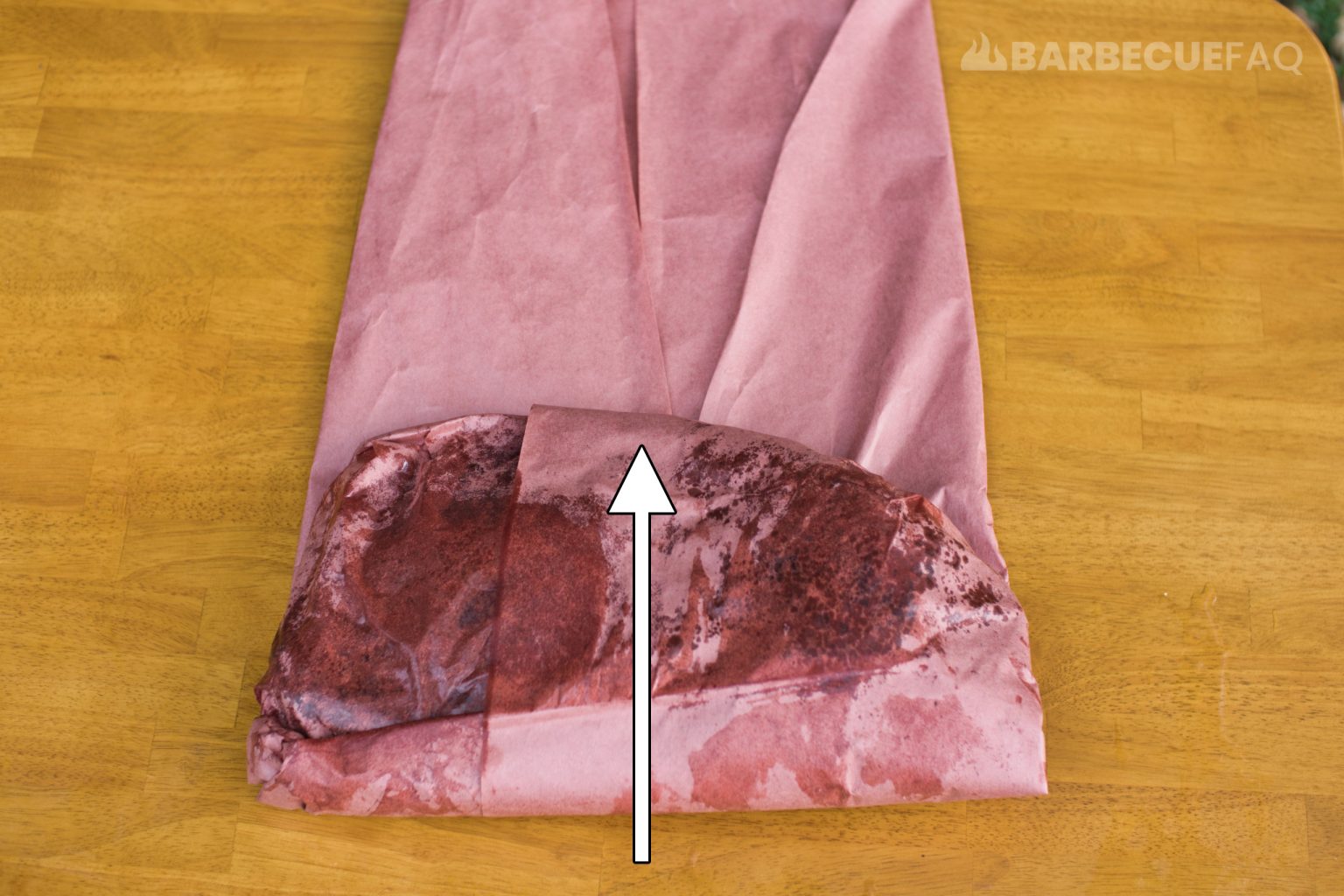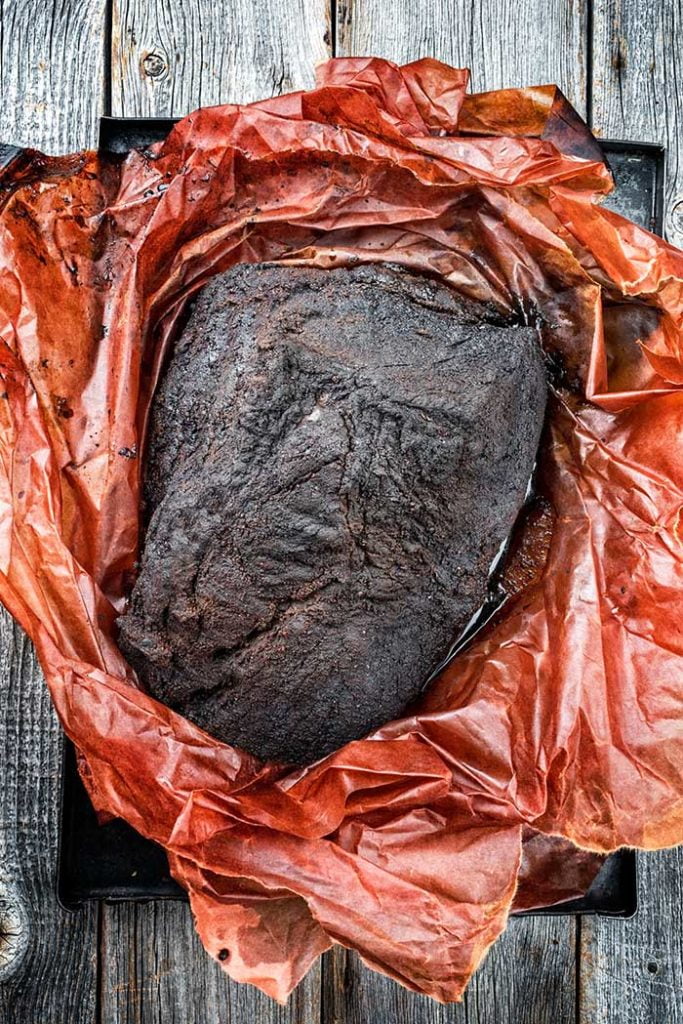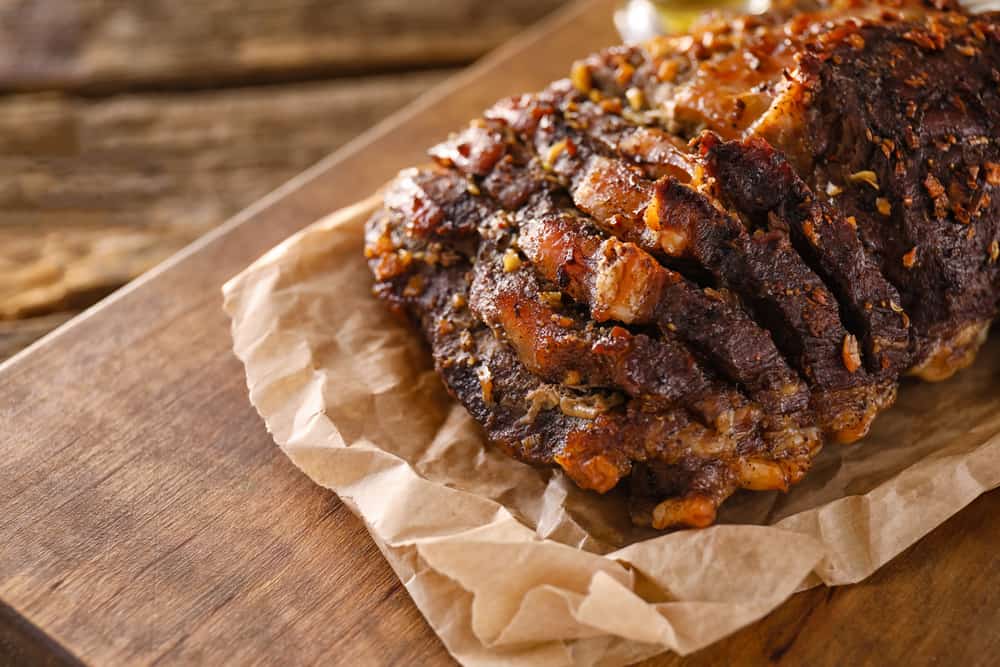When To Wrap A Brisket: The Ultimate Guide To Brisket Perfection
When should you wrap a brisket? Brisket wrapping is an important step in the smoking process, as it helps to keep the meat moist and juicy. But when is the best time to wrap a brisket?
The best time to wrap a brisket is when the internal temperature reaches 165 degrees Fahrenheit. At this point, the brisket has absorbed enough smoke flavor and the collagen has begun to break down, making the meat more tender. Wrapping the brisket will help to prevent it from drying out and will also help to speed up the cooking process.
To wrap a brisket, simply remove it from the smoker and wrap it tightly in butcher paper or aluminum foil. Be sure to seal the edges of the wrap tightly to prevent any smoke or moisture from escaping.
- Wade Wilson Crime Scene Photos
- Evan James Springsteen
- George Jones Cd
- Barry Statham
- Andy Griffith The Darlings
Return the brisket to the smoker and continue to cook it until the internal temperature reaches 203 degrees Fahrenheit. At this point, the brisket is done and can be removed from the smoker and allowed to rest for at least 30 minutes before slicing and serving.
Wrapping a brisket is a simple but important step in the smoking process. By following these tips, you can ensure that your brisket turns out moist, juicy, and flavorful.
When to Wrap a Brisket
Key Aspects
- Prevents the brisket from drying out: Wrapping the brisket helps to create a moist environment, which prevents the meat from drying out.- Speeds up the cooking process: Wrapping the brisket helps to insulate the meat, which speeds up the cooking process.- Enhances the flavor of the brisket: Wrapping the brisket helps to trap the smoke and moisture, which enhances the flavor of the meat.{point}
- Risks and mitigations: There are some risks associated with wrapping a brisket too early. If the brisket is wrapped too early, the meat may not absorb enough smoke flavor. To mitigate this risk, wait until the brisket has absorbed enough smoke flavor before wrapping it.- Impacts and implications: Wrapping a brisket can have a number of impacts on the cooking process. Wrapping the brisket can help to prevent the brisket from drying out, speed up the cooking process, and enhance the flavor of the brisket.{point}
- Cause and effect: Wrapping a brisket can have a number of effects on the cooking process. Wrapping the brisket can help to prevent the brisket from drying out, speed up the cooking process, and enhance the flavor of the brisket. - Practical significance: Wrapping a brisket is a simple but important step in the smoking process. By following these tips, you can ensure that your brisket turns out moist, juicy, and flavorful.When to Wrap a Brisket
Wrapping a brisket is an important step in the smoking process, as it helps to keep the meat moist and juicy. But when is the best time to wrap a brisket? Here are seven key aspects to consider:
- David Muirs Wedding Pictures
- Jake Gyllenhaal Height In Feet
- On Firetom Selleck 2024 Photos
- Courtney Love And Kurt Cobain Daughter
- Simone Biles Pregnancy
- Internal temperature: The best time to wrap a brisket is when the internal temperature reaches 165 degrees Fahrenheit.
- Smoke flavor: Wrapping the brisket too early can prevent it from absorbing enough smoke flavor.
- Cooking time: Wrapping the brisket can help to speed up the cooking process.
- Moisture retention: Wrapping the brisket helps to create a moist environment, which prevents the meat from drying out.
- Bark formation: Wrapping the brisket can help to prevent the bark from becoming too thick and tough.
- Tenderness: Wrapping the brisket can help to make the meat more tender.
- Resting time: After wrapping the brisket, it is important to let it rest for at least 30 minutes before slicing and serving.
These are just a few of the key aspects to consider when deciding when to wrap a brisket. By following these tips, you can ensure that your brisket turns out moist, juicy, and flavorful.
Internal temperature
The internal temperature of a brisket is one of the most important factors to consider when deciding when to wrap it. Wrapping the brisket too early can prevent it from absorbing enough smoke flavor, while wrapping it too late can cause it to dry out. The ideal internal temperature to wrap a brisket is 165 degrees Fahrenheit. At this temperature, the brisket has absorbed enough smoke flavor and the collagen has begun to break down, making the meat more tender. Wrapping the brisket will help to prevent it from drying out and will also help to speed up the cooking process.
There are a few different ways to measure the internal temperature of a brisket. The most accurate way is to use a meat thermometer. Insert the thermometer into the thickest part of the brisket, being careful not to touch any bones. The thermometer should read 165 degrees Fahrenheit when inserted into the center of the brisket.
Once the brisket has reached an internal temperature of 165 degrees Fahrenheit, remove it from the smoker and wrap it tightly in butcher paper or aluminum foil. Be sure to seal the edges of the wrap tightly to prevent any smoke or moisture from escaping. Return the brisket to the smoker and continue to cook it until the internal temperature reaches 203 degrees Fahrenheit. At this point, the brisket is done and can be removed from the smoker and allowed to rest for at least 30 minutes before slicing and serving.
Wrapping a brisket at the correct internal temperature is essential for achieving a moist, juicy, and flavorful brisket. By following these tips, you can ensure that your brisket turns out perfectly every time.
Smoke flavor
When smoking a brisket, it is important to allow the meat to absorb enough smoke flavor before wrapping it. Wrapping the brisket too early can prevent the meat from absorbing enough smoke flavor, resulting in a less flavorful brisket.
- Role of smoke flavor in brisket: Smoke flavor is an important part of the brisket smoking process. Smoke flavor adds a distinctive flavor to the meat and helps to create a crispy bark.
- How wrapping too early affects smoke flavor: Wrapping the brisket too early can prevent the meat from absorbing enough smoke flavor. This is because the wrap creates a barrier between the meat and the smoke, preventing the smoke flavor from penetrating the meat.
- Tips for ensuring enough smoke flavor: To ensure that your brisket absorbs enough smoke flavor, it is important to wait until the meat has developed a good bark before wrapping it. A good bark will help to seal in the smoke flavor and prevent the meat from drying out.
- Consequences of not having enough smoke flavor: A brisket that does not have enough smoke flavor will be less flavorful and less enjoyable to eat.
By following these tips, you can ensure that your brisket absorbs enough smoke flavor and turns out moist, juicy, and flavorful.
Cooking time
Wrapping the brisket can help to speed up the cooking process by creating a more insulated environment. This is because the wrap helps to trap heat and moisture, which allows the brisket to cook more quickly. In addition, wrapping the brisket can help to prevent the meat from drying out, which can also slow down the cooking process.
There are a few things to keep in mind when wrapping a brisket to speed up the cooking process. First, it is important to make sure that the brisket is cooked to an internal temperature of at least 165 degrees Fahrenheit before wrapping it. This will help to ensure that the brisket is safe to eat and that it has absorbed enough smoke flavor. Second, it is important to wrap the brisket tightly in butcher paper or aluminum foil. This will help to create a more insulated environment and prevent the brisket from drying out.
Wrapping the brisket can be a great way to speed up the cooking process and ensure that the brisket is cooked evenly. By following these tips, you can ensure that your brisket turns out moist, juicy, and flavorful.
Moisture retention
Wrapping the brisket is an important step in the smoking process, as it helps to keep the meat moist and juicy. When the brisket is wrapped, it creates a moist environment that helps to prevent the meat from drying out. This is especially important during the long cooking process, as brisket can easily become dry and tough if it is not properly hydrated.
- Role of moisture in brisket: Moisture is an essential component of brisket, as it helps to keep the meat tender and juicy. When the brisket is cooked, the moisture in the meat evaporates, which can cause the meat to become dry and tough. Wrapping the brisket helps to prevent this by creating a moist environment that helps to retain the moisture in the meat.
- How wrapping helps retain moisture: Wrapping the brisket helps to retain moisture in the meat by creating a barrier between the meat and the heat. This barrier helps to prevent the moisture from evaporating, which keeps the meat moist and juicy.
- Consequences of not wrapping the brisket: If the brisket is not wrapped, the moisture in the meat will evaporate, which will cause the meat to become dry and tough. This will make the brisket less flavorful and less enjoyable to eat.
By wrapping the brisket, you can help to ensure that the meat stays moist and juicy throughout the cooking process. This will result in a more flavorful and enjoyable brisket that your guests will love.
Bark formation
When smoking a brisket, it is important to develop a good bark on the meat. Bark is the crispy, flavorful layer that forms on the outside of the brisket during the smoking process. However, if the brisket is wrapped too early, the bark can become too thick and tough. This can make the brisket difficult to eat and less flavorful.
- Role of bark in brisket: Bark is an important part of brisket, as it adds flavor and texture to the meat. Bark is formed when the collagen in the brisket breaks down and caramelizes. This process creates a crispy, flavorful layer on the outside of the brisket.
- How wrapping too early affects bark formation: Wrapping the brisket too early can prevent the bark from forming properly. This is because the wrap creates a barrier between the meat and the smoke, preventing the smoke flavor from penetrating the meat. As a result, the bark will be less flavorful and less crispy.
- Tips for preventing thick and tough bark: To prevent the bark from becoming too thick and tough, it is important to wait until the brisket has developed a good bark before wrapping it. A good bark will help to seal in the smoke flavor and prevent the meat from drying out. Once the brisket has developed a good bark, you can wrap it tightly in butcher paper or aluminum foil to help speed up the cooking process.
By following these tips, you can ensure that your brisket develops a flavorful, crispy bark that will make your guests rave.
Tenderness
Wrapping the brisket is an important step in the smoking process, as it helps to keep the meat moist and juicy. But did you know that wrapping the brisket can also help to make the meat more tender?
- Collagen breakdown: When brisket is cooked, the collagen in the meat breaks down and turns into gelatin. This process makes the meat more tender and juicy. Wrapping the brisket helps to create a moist environment that speeds up the collagen breakdown process.
- Moisture retention: Wrapping the brisket helps to retain moisture in the meat, which also contributes to tenderness. When the brisket is wrapped, it is less likely to dry out, which makes it more tender and juicy.
- Even cooking: Wrapping the brisket helps to cook the meat evenly, which can also contribute to tenderness. When the brisket is wrapped, it is less likely to overcook or undercook, which can make it more tough or dry.
- Resting: After the brisket is cooked, it is important to let it rest for at least 30 minutes before slicing and serving. This allows the juices to redistribute throughout the meat, which makes it more tender and flavorful.
By following these tips, you can ensure that your brisket turns out moist, juicy, and tender every time.
Resting time
Resting the brisket is an important step in the smoking process, as it allows the juices to redistribute throughout the meat, resulting in a more tender and flavorful brisket. When wrapping a brisket, it is important to consider the resting time as part of the overall cooking process.
If the brisket is not rested properly, the juices will not have time to redistribute, resulting in a dry and tough brisket. The resting time also allows the brisket to continue cooking slightly, which helps to further tenderize the meat.
As a general rule, it is recommended to let the brisket rest for at least 30 minutes before slicing and serving. However, the resting time can vary depending on the size and thickness of the brisket. For larger briskets, a longer resting time may be necessary.
Here are some tips for resting a brisket:
- Remove the brisket from the smoker and wrap it tightly in butcher paper or aluminum foil.
- Place the wrapped brisket in a warm place, such as an oven set to the lowest temperature setting.
- Let the brisket rest for at least 30 minutes, or up to 2 hours.
- Unwrap the brisket and slice against the grain.
By following these tips, you can ensure that your brisket turns out moist, juicy, and flavorful every time.
FAQs about "When to Wrap a Brisket"
Wrapping a brisket is an important step in the smoking process, as it helps to keep the meat moist and juicy. But when is the best time to wrap a brisket? Here are some frequently asked questions about when to wrap a brisket:
Question 1: What is the best internal temperature to wrap a brisket?
Answer: The best internal temperature to wrap a brisket is 165 degrees Fahrenheit. At this temperature, the brisket has absorbed enough smoke flavor and the collagen has begun to break down, making the meat more tender. Wrapping the brisket will help to prevent it from drying out and will also help to speed up the cooking process.
Question 2: How long should I rest a brisket after wrapping it?
Answer: It is important to let the brisket rest for at least 30 minutes after wrapping it. This will allow the juices to redistribute throughout the meat, resulting in a more tender and flavorful brisket.
Wrapping a brisket is a simple but important step in the smoking process. By following these tips, you can ensure that your brisket turns out moist, juicy, and flavorful every time.
Conclusion
Wrapping a brisket is an important step in the smoking process, as it helps to keep the meat moist and juicy. The best time to wrap a brisket is when the internal temperature reaches 165 degrees Fahrenheit. At this temperature, the brisket has absorbed enough smoke flavor and the collagen has begun to break down, making the meat more tender. Wrapping the brisket will help to prevent it from drying out and will also help to speed up the cooking process.
Once the brisket is wrapped, it is important to let it rest for at least 30 minutes before slicing and serving. This will allow the juices to redistribute throughout the meat, resulting in a more tender and flavorful brisket.
By following these tips, you can ensure that your brisket turns out moist, juicy, and flavorful every time.

How to Wrap Brisket in Butcher Paper A Guide with Pictures! Barbecue FAQ

When to Wrap Brisket [Temperature, HowTo & Smoking Tips

When To Wrap Brisket And How To Do It Right Smokey Grill BBQ